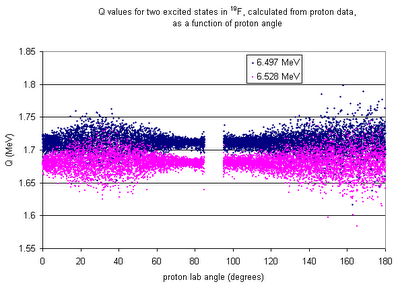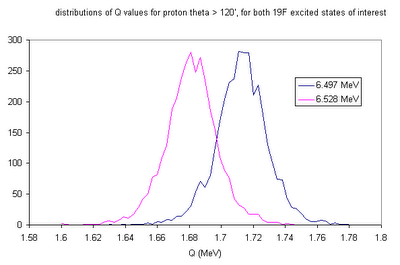The input:
- 90 MeV 18F beam (corresponds to optimum beam energy of 5 MeV/u)
- 20 μg/cm2 DH2 target
- detectors with arbitrary granularity (i.e. pixel size): take the S2 as a starting point: test the effect of changing the theta (annular) strip pitch from 0.5 mm to 1 mm; test the effect of having 16 or 32 phi (radial) strips.
- energy/angular straggling parameters derived from SRIM
- energy spread of the beam entering the target
- exact cross section (have assumed isotropic distribution in the centre of mass frame).
Test, independently, all the different possible contributions to the final Q resolution:
- energy loss/straggling and angular straggling of beam through the target
- energy and angular straggling of the outgoing particles through the target (assume we can reconstruct the energy perfectly, so count the energy straggling but not the energy loss)
- energy straggling of particles in the detectors
- energy resolution of detectors
- beam spot size
- granularity of detectors
- Monte Carlo simulation of reaction
- use relativistic energy/momentum to calculate Q (n.b. this is different from e.g. the LLN experiment, where non-relativistic energy/momentum were good enough)
(click on the image for a larger version)

What the graph shows: the standard deviation of the Q values calculated using each different method.
"Qp" means the Q value calculated using only data from the protons; "Qa15" means that only data from the alpha and 15N are used; Qcalc means that a complicated bit of algebra is done to eliminate the proton and 15N energies and to reconstruct the beam energy before the reaction.
the different cases:
- "perfect": no energy losses: Q is calculated using the initial energies/angles of all particles
- "beam in target": the reaction takes place at a randomly chosen depth in the target, and uses the beam's modified energy/angle at that point
- "detector energy resolution": see what effect the detector's resolution has: add a gaussian with 15 keV fwhm to a particle's energy
- "particles in target": calculate energy/angle straggling of outgoing particles through the target
- "particles in deadlayer": calculate energy straggling of particles in the deadlayer: assume that the detector is flat and perpendicular to the beamline
- "particles in deadlayer, incidence angle = 0": same as above, only assume that the particles always hit the detectors square on.
- "beamspot size": assume that the beam has a circular profile, with gaussian shapes in the both x and y directions, with σ=1 mm: calculate the precise position of the particles on the detectors, 500 mm down- and upstream.
- "detector granularity (standard)": the detectors have 0.5 mm strip pitch and 32 strips in φ,are of infinite extent, and are located 500 mm down- and upstream: calculate the effective position of the particles on the detectors: i.e. the location of the middle of the pixels that the particles hit.
- "detector granularity: 16 phi strips": decrease the number of phi strips
- "detector granularity: strip pitch 1 mm": increase the strip pitch
The α+15N method isn't as bad as Qcalc for the granular-detector cases, but it's still pretty bad.
For Qp, the sizes of the spreads in Q introduced by the various factors are all roughly on the same order. They also all depend on the angle of the protons: in some cases they're stronger at backward angles, and in some cases weaker.
Calculate Qp, using all factors combined, and see what the total angular dependence is.
Input: detectors are perpendicular to the beam line, located at 500 mm from the target, and have 0.5 mm theta strip pitch and 32 phi strips; the beam has σ=1 mm; Q is calculated using (proton energy = initial energy + straggling through target + straggling through dead layer + detector resolution factor) and (proton angle = initial angle + angular straggling through target) and (beam energy = average beam energy half way through the target).
Results: Q value as a function of angle, for the two states of interest...

Distribution of Q values for high-angle protons (i.e. theta > 120')

It looks like it's at least possible in theory to make this measurement!
No comments:
Post a Comment